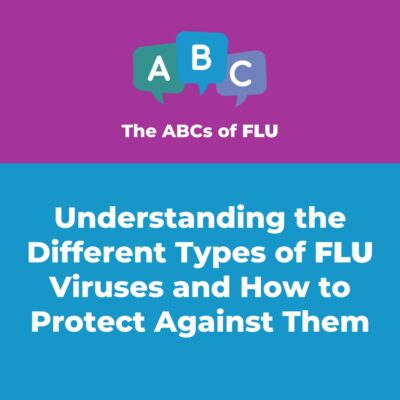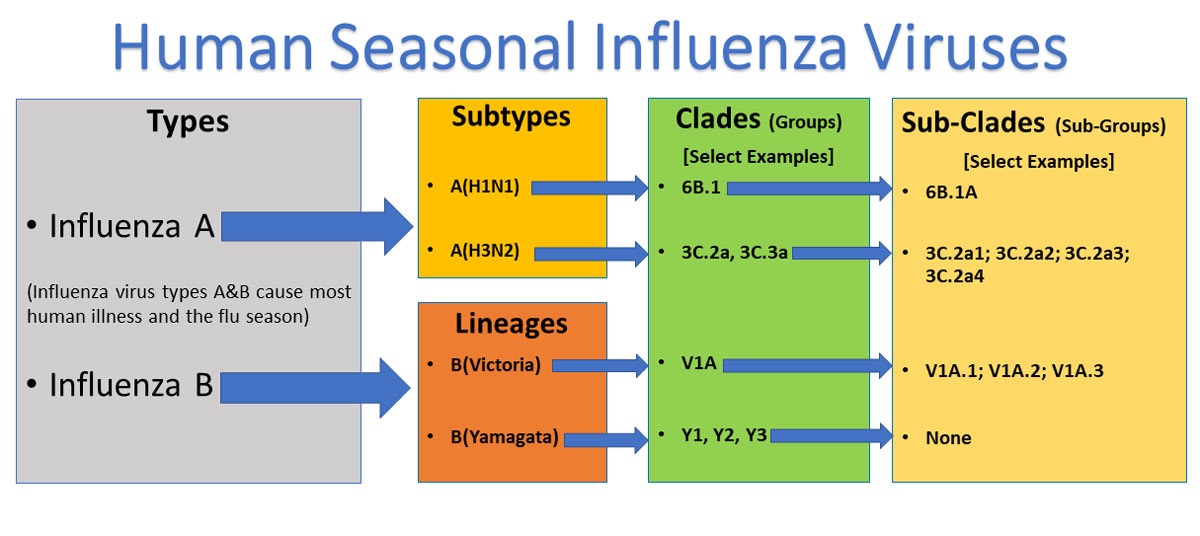- Flu Facts
Understanding the Different Types of Flu Viruses – and How to Protect Against Them

We all know the ABCs – but do you know the ABCs of flu? There are four types of influenza viruses: A, B, C, and D. Influenza A and B viruses cause seasonal epidemics (also known as flu season) almost every winter in the United States, per the CDC.
Why is this important to know? Given there is a lot of misinformation online right now when it comes to health and because of vaccine hesitancy, this information can keep you informed to make the best decisions for you and your family and stay healthy. And, since the virus and the vaccine change every year, it is important to get a flu vaccination annually. Influenza vaccination is safe and effective and is the single best way to help protect from the flu each year. Let’s break it down.

Image via CDC
The ABCs of Flu
According to the CDC, Influenza A viruses are the only influenza viruses known to cause flu pandemics. (Thankfully, we are not currently in a flu pandemic!) This occurs when a new and different influenza A virus emerges that infects people, has the ability to spread efficiently among people, and against which people have little or no immunity. As mentioned, Influenza A and B viruses cause seasonal epidemics each year, which we call flu season. As of January 7, 2023, the current 2022-2023 flu season, there have been 2 million illnesses, 260,000 hospitalizations, and 16,000 deaths from flu, including 79 pediatric deaths.
Influenza C virus infections generally cause mild illness and are not thought to cause human epidemics. Influenza D viruses primarily affect cattle and are not known to infect or cause illness in people.
In addition, Influenza A viruses are divided into subtypes based on two proteins on the surface of the virus: hemagglutinin (H) and neuraminidase (N). Each flu season, the CDC dives into the data to determine the effectiveness of that season’s influenza vaccine. Most recently, they reported that of the influenza A viruses detected and subtyped during the week ending December 31, 2022, 70 percent were influenza A(H3N2), and 30 percent were influenza A(H1N1). And the majority of influenza viruses tested are in the same genetic subclade as and antigenically similar to the influenza viruses included in this season’s influenza vaccine. If it sounds a little confusing, this means that the types of flu strains circulating right now are included in the vaccine, offering you more protection from what’s currently out there. All the more reason to get your flu shot! Not to mention, the viruses collected and evaluated this season have been susceptible to some influenza antivirals (oseltamivir, peramivir, zanamivir, and baloxavir). Antivirals can be prescribed if you test positive for flu and are most effective if taken within 48 hours of when symptoms start.
Flu vaccines have been used since 1945 with very good safety records. Vaccines go through years of research and clinical trials before they are made available to the general public, and scientists work hard every year to study and learn from each flu season. Just take a look at the data they’ve gathered over the years.
Flu vaccines can reduce the chances of getting sick with the flu by up to 60 percent. Even if you still get sick, vaccinated people have less severe flu symptoms and are less likely to be hospitalized or die from flu-related complications. Remember, even young and healthy individuals can suffer from severe complications from the flu. It does not discriminate, and as it continues to change and evolve from season to season, getting vaccinated is your best defense to fight the flu!

